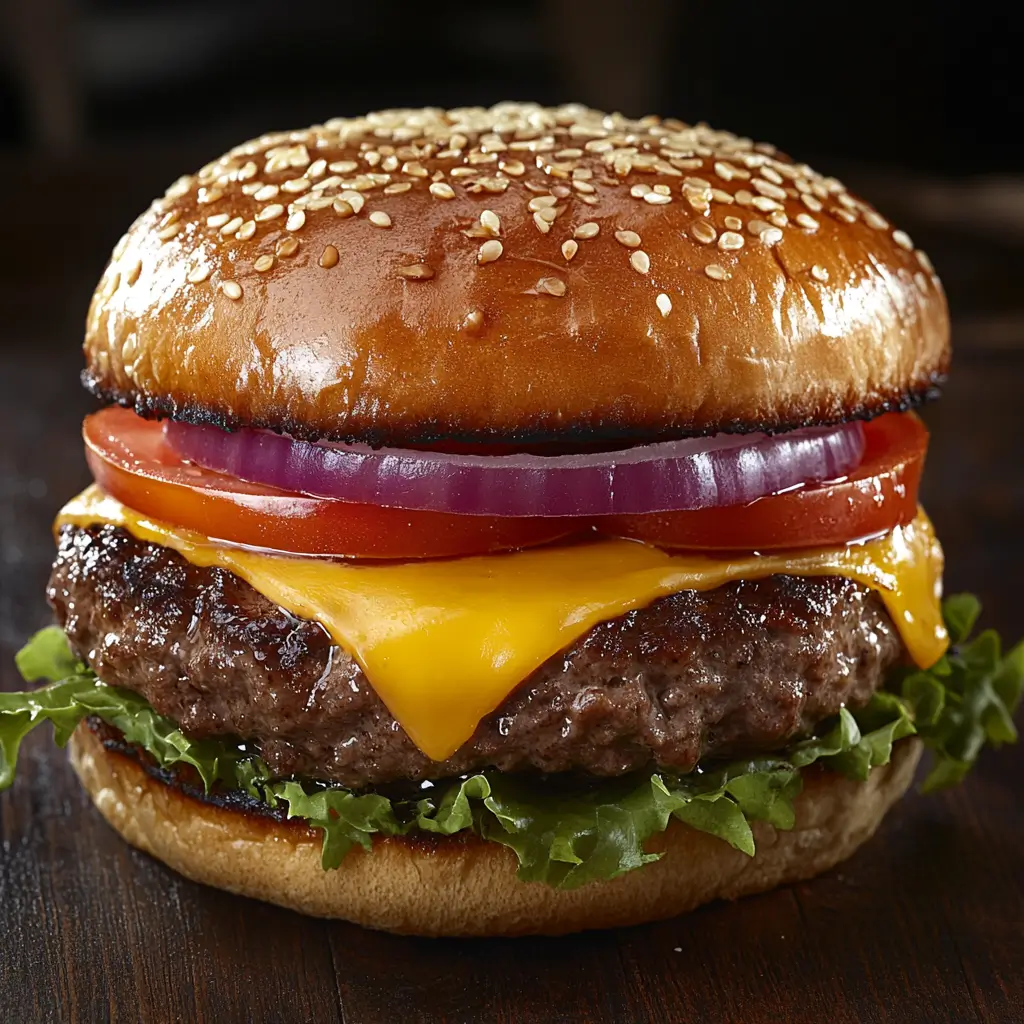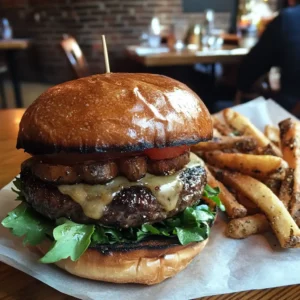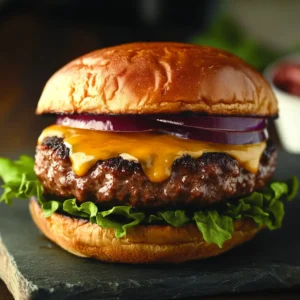Keep Bison Burgers Together: Expert Tips for Success
Bison burgers are a healthy and flavorful alternative to beef, but their lean composition often makes them difficult to work with. To keep bison burgers together, you’ll need the right combination of ingredients, handling techniques, and cooking methods. By following these expert tips, you can create bison patties that are juicy, flavorful, and structurally sound. Let’s explore the best ways to make bison burgers that won’t crumble.
Introduction to Bison Burgers
Why Bison Meat Is Different From Beef
Bison meat is a naturally lean and nutrient-dense alternative to traditional beef, making it a popular choice for those seeking healthier protein options. With significantly less fat than beef, bison offers a distinctive flavor profile that is slightly sweeter and a firmer texture that sets it apart. These qualities make bison meat an excellent option for health-conscious individuals looking to reduce fat intake without sacrificing taste or nutrition.
In addition to being lower in fat, bison meat is rich in essential nutrients like iron, zinc, and B vitamins, which support energy production, immune health, and overall well-being. However, its lean nature can also pose challenges, particularly when forming bison burgers. The lower fat content can make the meat more prone to drying out and less forgiving during cooking, requiring extra care and the right techniques to achieve juicy, flavorful burgers.
Despite these challenges, bison meat’s health benefits and unique flavor have made it a favorite among food enthusiasts and those looking for a premium, nutrient-rich alternative to beef. With the right seasonings and preparation methods, bison burgers can be a delicious, satisfying addition to your diet.
Common Challenges in Cooking Bison Burgers
Overhandling the meat during preparation can also contribute to this issue, as it breaks down the structure of the meat, making it harder to hold its shape. Additionally, cooking bison burgers at too high a temperature can cause them to dry out quickly, further compromising their texture and stability.
To prevent crumbling and ensure delicious, well-formed burgers, it’s important to handle the meat gently, incorporate a binding agent if necessary, and cook the burgers at a moderate temperature. These steps help maintain the integrity of the burger while highlighting the unique, flavorful qualities of bison meat.
Understanding the Characteristics of Bison Meat
Lower Fat Content and Its Impact
The reduced fat content in bison meat is both a benefit and a challenge. On one hand, it makes bison a healthier choice, as it contains fewer calories and saturated fats compared to beef. On the other hand, the lack of fat can lead to drier, less cohesive patties if not handled correctly. Fat in ground meat acts as a natural binder, helping to hold patties together and retain moisture during cooking.
In the absence of this fat, compensatory techniques are essential to ensure juicy, well-formed bison burgers. Adding a binder, such as an egg, breadcrumbs, or even a splash of olive oil, can improve the patty’s cohesion and texture. Additionally, avoiding overmixing the meat and cooking it at a moderate temperature can help maintain its natural moisture and structure.
With the right preparation, you can enjoy the health benefits of bison meat while still achieving flavorful, tender patties that hold together beautifully.
Nutritional Benefits of Bison Meat
Bison meat is a nutrient powerhouse, packed with high-quality protein, iron, zinc, and omega-3 fatty acids. This combination makes it an excellent choice for individuals looking to build muscle, support overall health, or maintain a balanced diet. The lean nature of bison meat provides all these benefits while being lower in calories and saturated fat compared to traditional beef. Not only is it a healthier option, but it also delivers rich, savory flavors, making it perfect for crafting delicious and nutritious burgers that satisfy both your taste buds and dietary goals.
Flavor Profile and Texture of Bison
Bison meat is known for its tender texture and rich, flavorful taste, with a natural sweetness that distinguishes it from beef. Its lean composition not only makes it a healthier option but also contributes to a slightly denser texture. This unique characteristic presents both a challenge and an opportunity for creative cooks. The lean nature requires careful preparation to prevent dryness, but it also allows for innovative recipes and cooking techniques that bring out the best in bison’s distinctive flavor and texture. Whether you’re making burgers, steaks, or ground meat dishes, bison offers a delicious and versatile alternative to traditional red meat.
Common Reasons Bison Burgers Fall Apart
Lack of Fat Binding in Ground Bison
Fat serves as a natural binder in ground meat, helping patties maintain their shape and stay cohesive during cooking. In the case of bison burgers, the low fat content makes them more prone to falling apart, particularly when exposed to heat. This lack of fat can compromise the burger’s structure, requiring extra care and the use of binding agents or specific techniques to keep the patties intact. Proper preparation is essential to ensure bison burgers hold their shape while delivering a tender, flavorful bite.
Overhandling the Meat During Preparation
When making bison burgers, it’s important to handle the meat gently. Overworking the meat can break down its fibers and release excess moisture, which makes it difficult to form a cohesive patty. Additionally, overmixing can lead to a dense, tough texture, which detracts from the burger’s tenderness. To achieve the perfect bison burger, gently mix the meat with minimal handling, ensuring it remains light and juicy while maintaining its structure during cooking.
Cooking Temperatures and Their Effects
Bison meat cooks faster than beef due to its lower fat content. While this makes it a leaner option, it also means the meat is more prone to drying out if cooked at too high a temperature. Cooking bison at a moderate heat helps retain its moisture and tenderness, ensuring the meat doesn’t become too dry or crumble. To get the best results, it’s important to monitor the cooking process closely and avoid overheating, allowing the natural flavors and texture of the bison to shine.
Essential Tips for Making Perfect Bison Burgers
Choosing the Right Ground Bison Blend
For the best results when making bison burgers, aim for ground bison that contains at least 10% fat. This fat content helps ensure the burgers stay juicy and cohesive during cooking. If you can’t find a fattier blend, consider adding extra fat to the mix, such as olive oil, bacon grease, or even butter. These additions will help bind the meat together, prevent the burgers from drying out, and enhance the flavor, creating a more tender and flavorful patty.
The Role of Binding Agents in Burger Stability
Adding binders like eggs, breadcrumbs, or grated cheese can significantly improve the cohesion of your bison patties. These ingredients work as structural reinforcements, helping to hold the meat together during cooking and preventing the patties from falling apart. Eggs provide moisture and help bind the ingredients, while breadcrumbs add texture and absorb excess moisture. Grated cheese can also add a rich flavor while aiding in holding the patty together. Using one or a combination of these binders ensures your bison burgers stay firm, juicy, and easy to flip without crumbling.
Adding Moisture Without Overdoing It
Incorporating moisture-rich ingredients such as finely chopped onions, mushrooms, or a splash of Worcestershire sauce can significantly improve the texture and flavor of bison burgers. These additions help retain moisture, preventing the meat from drying out and ensuring the patties remain juicy and tender. Onions add both moisture and a slight sweetness, while mushrooms contribute earthiness and extra moisture. Worcestershire sauce adds a savory depth of flavor that enhances the overall taste profile. By adding these ingredients, you can create bison burgers that are not only flavorful but also tender and succulent, even with the leaner nature of the meat.
Step-by-Step Guide to Preparing Bison Burgers
Selecting Ingredients for Optimal Results
Start with fresh, high-quality ground bison. Choose complementary ingredients like garlic, herbs, and spices to enhance the natural sweetness of the meat.
Mixing Techniques to Maintain Meat Integrity
Gently combine your ingredients without overworking the meat. Use your hands to mix until just combined, ensuring the texture of the bison remains intact.
Shaping Patties for Even Cooking
Form patties that are about ¾ inch thick with a slight dimple in the center. The dimple prevents the burgers from puffing up during cooking and ensures even doneness.
Cooking Techniques to Keep Bison Burgers Together
Cooking bison patties requires a delicate touch to keep them together and maintain their juiciness. Follow these tips:
- Cook at Medium Heat: High heat can dry out the patties, making them prone to crumbling.
- Flip Once: Resist the urge to flip the burgers multiple times. Doing so can weaken their integrity.
- Use a Thermometer: Ensure the internal temperature reaches 140°F for medium-rare or 160°F for medium.
Pan-Seared vs. Grilled Bison Burgers
Both methods can yield delicious results. Grilling adds a smoky flavor, while pan-searing retains more moisture. Use a well-oiled cast iron skillet or grill to prevent sticking.
Best Practices for Maintaining Juiciness
Avoid pressing down on the patties while cooking, as this releases precious juices. Cook bison burgers to medium-rare or medium for the best results, as overcooking can dry them out.
Temperature Control for Perfect Patties
Use a meat thermometer to check the internal temperature. Aim for 140°F for medium-rare or 160°F for medium. Remove the patties from heat slightly below the desired temperature, as they will continue to cook while resting.
Creative Additions to Enhance Bison Burgers
Incorporating Vegetables and Cheese
Add finely shredded vegetables like zucchini or carrots for extra moisture and flavor. Cheese, whether mixed into the patty or melted on top, adds richness and helps bind the ingredients.
Unique Sauces and Seasonings
Experiment with bold flavors like chipotle, smoked paprika, or Dijon mustard. Incorporate sauces such as aioli or barbecue sauce to elevate your burger.
Complementary Toppings for Bison Burgers
Enhance your burger with toppings like caramelized onions, avocado, or pickled jalapeños. These additions balance the natural sweetness of the bison.
Troubleshooting Common Issues
Salvaging a Crumbly Patty
If your patties are falling apart, try adding an egg or more breadcrumbs to the mixture. These binders will help the patties hold their shape.
Adjusting Ingredients on the Fly
If the mixture feels too dry, add a splash of milk or olive oil. If it’s too wet, incorporate additional dry binders like breadcrumbs or crushed crackers.
Storing and Reheating Bison Burgers
Best Practices for Freezing Patties
To freeze uncooked patties, stack them with parchment paper in between to prevent sticking. Wrap tightly in plastic wrap and store in an airtight container for up to three months.
Reheating Without Losing Flavor
Reheat cooked patties in a skillet with a splash of water or broth to restore moisture. Avoid microwaving, as it can dry out the meat.
Health Benefits of Including Bison in Your Diet
High Protein Content and Lean Nutrition
Bison burgers are an excellent source of lean protein, making them ideal for athletes, bodybuilders, and anyone focused on maintaining a healthy diet.
Supporting Sustainable and Ethical Eating
Bison are often raised on open pastures and fed grass, making their meat more sustainable and environmentally friendly than conventionally raised beef.
FAQs: How Do You Keep Bison Burgers Together?
1. What’s the best way to bind bison patties?
Adding an egg and breadcrumbs to the ground bison mixture is the easiest way to keep the burgers together.
2. Why do bison burgers crumble during cooking?
This happens due to the meat’s low-fat content. Using binders and cooking gently helps prevent crumbling.
3. Can I freeze bison patties?
Yes! Freezing pre-formed patties with parchment paper between them ensures they hold their shape during storage.
4. How do I prevent bison burgers from drying out?
Incorporate moisture-rich ingredients like onions or mushrooms and avoid overcooking.
5. Can I keep bison burgers together without eggs?
Yes, you can use alternatives like grated cheese, mashed beans, or flaxseed meal mixed with water.
Conclusion: Master the Art of Bison Burgers
Keeping bison burgers together doesn’t have to be a challenge. By using the right binders, handling the meat gently, and cooking at the right temperature, you can enjoy perfectly juicy and structurally sound patties every time. With a little practice, you’ll be serving up bison burgers that rival the best beef burgers around!
Related article:
Bison Burger Recipe – A Perfect Guide to Making Delicious Bison Burgers
Is There Another Name for an Arm Roast?



